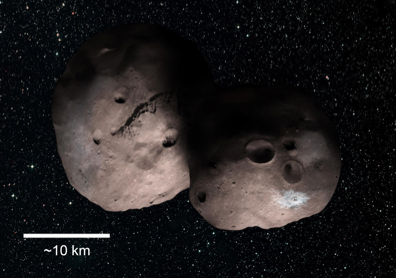The Flyby of Ultima Thule

NASA's New Horizons is the first mission to explore Pluto and the Kuiper Belt, a region just beyond Neptune whose discovery in the early 1990s has revolutionized our view of the solar system's architecture, population structure, formation, and evolution.
The New Horizons spacecraft was launched on Jan. 19, 2006, passed Jupiter for a gravity boost and science observations in February 2007, and made a historic flight through the Pluto system on July 14, 2015—returning data that transformed our view of these intriguing worlds on the planetary frontier.
New Horizons is now exploring deeper in the Kuiper Belt, observing a diverse range of Kuiper Belt objects (KBOs) and Centaurs, and measuring the Sun's heliosphere. But the main event of this five-year-long Kuiper Belt Extended Mission (KEM) takes New Horizons one billion miles (1.6 billion kilometers) beyond Pluto for a rendezvous with 2014 MU69— nicknamed Ultima Thule—likely the most primitive object ever visited by a spacecraft, on Jan. 1, 2019.
The New Horizons flyby of Ultima, set to be the farthest planetary encounter in history, adds another chapter to the missions remarkable story.
Astronomical Archaeology
The Kuiper Belt is a relic from our solar system's origin that preserves a record of the processes that shaped our planetary system over four billion years ago. We once thought New Horizons Path that Pluto marked the “end” of our solar system; but in fact, Pluto is a beginning—a gateway to a “third zone” of our planetary system beyond the terrestrial planets and gas giants. We now know that the dwarf planets in this zone outnumber the larger planets of the solar system.
The bodies in the Kuiper Belt are believed to hold keys to understanding fundamental aspects of planet formation, the origin of our solar system's architecture, and even some aspects of Earth's evolution—such as its early bombardment by impactors.
Exploring the Kuiper Belt has been a scientific priority for decades. Sending New Horizons into the Kuiper Belt is essentially NASA's version of an archaeological dig into the earliest history of the solar system—a close-up look at the remnants of the ancient planet-building process whose pristine chemistry has been held in a “deep freeze.”
Kuiper Belt Extended Mission Objectives
Conduct a close flyby of at least one KBO. Plans call for New Horizons to fly much closer to Ultima Thule than it did to Pluto or any of its satellites. Using all seven onboard science instruments, New Horizons will make extensive geological, geophysical, and compositional measurements, search for an atmosphere around Ultima, and obtain plasma/energetic particle data on the object; it also will search for and study any satellites or rings orbiting the KBO.
Survey the Kuiper Belt. On the way to Ultima Thule and for two years after passing it, New Horizons will observe the plasma (charged particles), gas, and dust within the Kuiper Belt, and perform unique observations of numerous distant KBOs that can't be accomplished from Earth or by any other spacecraft. New Horizons will train its cameras on approximately 25 KBOs, taking long-distance images to learn about their shapes and surface properties and to search for rings and moons around them. The spacecraft will also measure Kuiper Belt dust production and distribution, map the density of neutral gas in the heliosphere, measure plasma and energetic particles to better understand the heliosphere and how space weather affects KBOs, and search for dust around assorted KBOs and Centaurs to determine the frequency of their ring systems. During its extended mission, New Horizons will conduct these studies out to a distance of at least 50 times as far from the Sun as the Earth.
Meet Ultima Thule

Ultima Thule—officially named 2014 MU69—was discovered by New Horizons team members in 2014 using NASA's Hubble Space Telescope; it orbits more than four billion miles (6.5 billion kilometers) from Earth.
Other than its primitive nature, very little is known about Ultima aside from its orbit, its color—which is likely redder than Pluto—and its approximate size.
On July 17, 2017, this ancient KBO passed in front of a star. A handful of telescopes deployed by the New Horizons team in a remote part of Patagonia, Argentina, caught its fleeting shadow—an event known as an occultation—and captured important data to help the mission team plan the flyby and understand the size, shape, orbit, and environment around Ultima Thule. From these observations, scientists suspect Ultima could be a single bilobed or highly elongated object, or even two bodies orbiting very close together. It also appears to be no more than 20 miles (30 kilometers) long, or, if it is a binary, each component is about 9–12 miles (15–20 kilometers) in diameter.
Article courtesy of NASA. For more information about the New Horizons mission, visit: nasa.gov/newhorizons pluto.jhuapl.edu
